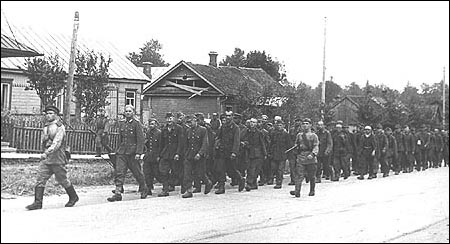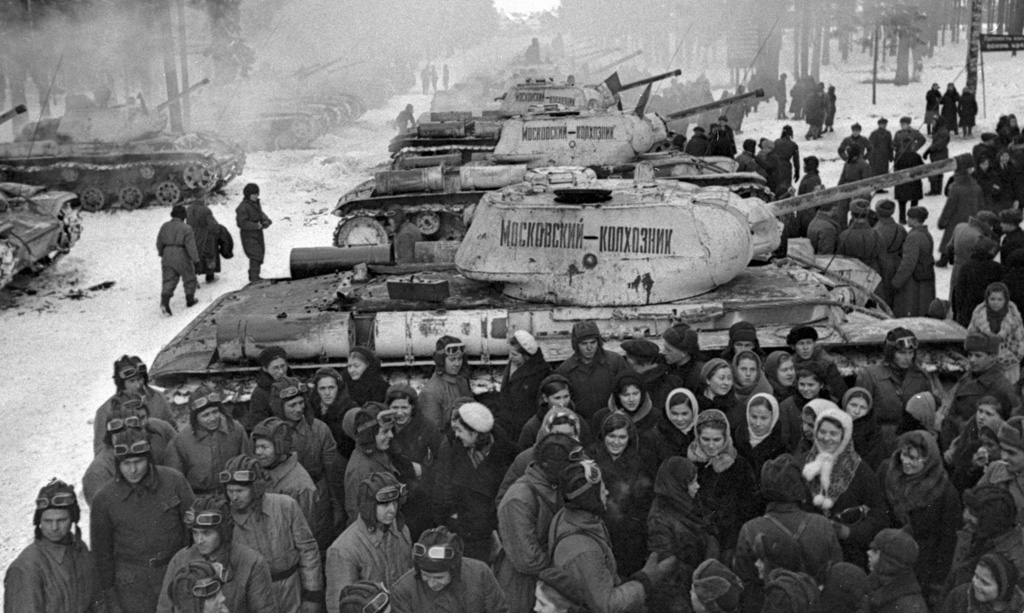|
Nevel Offensive
The Battle of Nevel was a successful military operation conducted by the Red Army in the Pskov Oblast of western Russia and in northern Belarus during World War II, from October 6 to roughly December 16, 1943 although fighting persisted in the area into the new year. The initial attack created an unexpected breakthrough of the German defenses and liberated the town of Nevel on the first day and subsequent attacks over the next four days created a salient about 35km wide and 25 km deep at the junction between German Army Groups North and Center. Through the following weeks the forces of 1st Baltic Front continued to expand the salient and attempt to outflank and encircle the units of German 16th Army and 3rd Panzer Army to its north and south while those same units, at Hitler's orders, "held the goalposts" and attempted to cut off the salient itself. Hitler finally conceded these efforts were futile on December 16 as 1st Baltic continued attacking southwards toward Vitebsk ... [...More Info...] [...Related Items...] OR: [Wikipedia] [Google] [Baidu] |
Eastern Front (World War II)
The Eastern Front of World War II was a Theater (warfare), theatre of conflict between the European Axis powers against the Soviet Union (USSR), Polish Armed Forces in the East, Poland and other Allies of World War II, Allies, which encompassed Central Europe, Eastern Europe, Northern Europe, Northeast Europe (Baltic states, Baltics), and Southeast Europe (Balkans) from 22 June 1941 to 9 May 1945. It was known as the Great Patriotic War (term), Great Patriotic War in the Soviet Union – and still is in some of its successor states, while almost everywhere else it has been called the ''Eastern Front''. In present-day German and Ukrainian historiography the name German-Soviet War is typically used. The battles on the Eastern Front of the Second World War constituted the largest military confrontation in history. They were characterised by unprecedented ferocity and brutality, wholesale destruction, mass deportations, and immense loss of life due to combat, starvation, expos ... [...More Info...] [...Related Items...] OR: [Wikipedia] [Google] [Baidu] |
Novosokolniki
Novosokolniki (russian: Новосоко́льники) is a town and the administrative center of Novosokolnichesky District in Pskov Oblast, Russia, located on the Maly Udray River at the junction of the St. Petersburg–Kyiv and Moscow–Riga railways, southeast of Pskov, the administrative center of the oblast. Population: History It was founded in 1901 due to construction of the railway between Moscow and Riga. At the time, it was a part of Velikoluksky Uyezd in Pskov Governorate. The name is due to the nearby locality then known as Sokolniki, whose name in turn is derived from the Russian word "russian: сокол" (''sokol'', meaning "falcon"), since the residents specialized on breeding falcons for hunting. Novosokolniki was granted town status in 1925. On August 1, 1927, the uyezds and governorates were abolished and Novosokolnichesky District, with the administrative center in Novosokolniki, was established as a part of Velikiye Luki Okrug of Leningrad Oblas ... [...More Info...] [...Related Items...] OR: [Wikipedia] [Google] [Baidu] |
379th Rifle Division (Soviet Union)
The 379th Rifle Division was raised in 1941 as an infantry division of the Red Army, and served for the duration of the Great Patriotic War in that role. It began forming in August 1941 in the Urals Military District. It first served in the winter counteroffensive west of Moscow, and later in the bitter fighting around the Rzhev salient, but was moved north late in 1942. It took up positions along the Volkhov River, mostly under command of the 8th Army, and continued to serve in this Army's battles near Leningrad until September 1943, when it was transferred to the 2nd Baltic Front, where it would stay for the remainder of its service. During this period the division served under many army and corps commands but mostly in the 3rd Shock Army. The division ended the war in Lithuania, helping to contain and reduce the German forces trapped in the Courland Pocket. By this time it was judged as being surplus to the Red Army's needs and in December 1944 its personnel were parceled out to ... [...More Info...] [...Related Items...] OR: [Wikipedia] [Google] [Baidu] |
Georg Von Küchler
Georg Carl Wilhelm Friedrich von Küchler (30 May 1881 – 25 May 1968) was a German field marshal and war criminal during World War II. He commanded the 18th Army and Army Group North during the Soviet-German war of 1941–1945. After the end of the war, he was tried in the High Command Trial, as part of the Subsequent Nuremberg trials. On 27 October 1948 he was sentenced to 20 years in prison for war crimes and crimes against humanity committed in the Soviet Union. He was released in 1953. Early life and World War I Born on 30 May 1881 at Schloss Philippsruhe, Küchler's family were Prussian Junker. He entered the Imperial Army in 1900 as an officer cadet in the artillery. He was posted to the 25th Field Artillery Regiment and the following year was commissioned as a ''Leutnant'' (second lieutenant). He remained in his regiment until 1907, when he was assigned to Military Riding School. He received a promotion to ''Oberleutnant'' (first lieutenant) in 1910 and studied at th ... [...More Info...] [...Related Items...] OR: [Wikipedia] [Google] [Baidu] |
Operation Mars
Operation Mars (Russian: Операция «Марс»), also known as the Second Rzhev-Sychevka Offensive Operation (Russian: Вторая Ржевско-Сычёвская наступательная операция), was the codename for an offensive launched by Soviet forces against German forces during World War II. It took place between 25 November and 20 December 1942 around the Rzhev salient in the vicinity of Moscow. The offensive was a joint operation of the Soviet Western Front and Kalinin Front co-ordinated by Georgy Zhukov. The offensive was one in a series of particularly-bloody engagements that are collectively known in Soviet and Russian histories as the Battles of Rzhev, which occurred near Rzhev, Sychevka and Vyazma between January 1942 and March 1943. The battles became known as the "Rzhev meat grinder" ("Ржевская мясорубка") for their huge losses, particularly on the Soviet side. For many years, they were relegated to a footnote in Sovi ... [...More Info...] [...Related Items...] OR: [Wikipedia] [Google] [Baidu] |
Bely, Tver Oblast
Bely (russian: Бе́лый) is a town and the administrative center of Belsky District in Tver Oblast, Russia, located on the Obsha River. Population: 6,900 (1897). History The name of the town means "white" in Russian, although it is unknown how or why this name originated. The fortress of Bely is first mentioned in a chronicle in 1350, since it was conquered by the Grand Duchy of Lithuania. It was located on the border between Lithuanian and Russian lands, and intermittently changed affiliation between Lithuania (later Poland) and the Grand Duchy of Moscow. In the 15th century, it became the seat of the Belsky branch of the ruling House of Gediminas. The town was overrun by the Grand Duchy of Moscow in 1503. Three years later, Muscovites built a formidable castle, which the Lithuanians laid a siege to in 1508. The town was again subordinated to the Polish–Lithuanian Commonwealth between 1618 and 1654, after which it finally went under Moscow. In the course of the admin ... [...More Info...] [...Related Items...] OR: [Wikipedia] [Google] [Baidu] |
Sturmgeschütz III
The ''Sturmgeschütz III'' (StuG III) assault gun was Germany's most-produced fully tracked armoured fighting vehicle during World War II, and second-most produced German armored combat vehicle of any type after the Sd.Kfz. 251 half-track. It was built on a slightly modified Panzer III chassis, replacing the turret with an armored, fixed superstructure mounting a more powerful gun. Initially intended as a mobile assault gun for direct-fire support for infantry, the StuG III was continually modified, and much like the later ''Jagdpanzer'' vehicles, was employed as a tank destroyer. Development The '' Sturmgeschütz'' originated from German experiences in World War I, when it was discovered that, during the offensives on the Western Front, the infantry lacked the means to engage fortifications effectively. The artillery of the time was heavy and not mobile enough to keep up with the advancing infantry to destroy bunkers, pillboxes, and other minor fortifications with direct ... [...More Info...] [...Related Items...] OR: [Wikipedia] [Google] [Baidu] |
Skoda 75 Mm Model 15
The Skoda 7.5 cm Gebirgskanone M. 15 was a mountain gun used by Austria-Hungary in World War I. In German service, it was known as the 7.5 cm GebK 15. The Italians designated them as the Obice da 75/13 and the Wehrmacht would designate captured guns as 7.5 cm GebK 259(i) after the surrender of Italy in 1943. History Its development was quite prolonged, as the Austrians couldn't decide on the specifications that they wanted. Initially, they wanted a gun that could be broken down into no more than five pack-animal loads to replace the various 7 cm mountain guns in service, but prolonged trials proved that the 7.5 cm M. 12 prototype to be the best gun. However, the commander-in-chief of Bosnia-Hercegovina believe it to be too heavy and demanded a return to the 7 cm caliber to save weight. Skoda dutifully built enough guns for a test battery in the smaller caliber and tested them during the spring of 1914 where they were judged inferior to the 7.5 cm ... [...More Info...] [...Related Items...] OR: [Wikipedia] [Google] [Baidu] |
2nd Luftwaffe Field Division
The 2nd ''Luftwaffe'' Field Division (german: 2. Luftwaffen-Feld-Division) was an infantry division of the ''Luftwaffe'' branch of the Wehrmacht that fought in World War II. It was formed using surplus ''Luftwaffe'' ground crew and served on the Eastern Front from late 1942 to October 1943, when it was destroyed and disbanded. Operational history The 2nd ''Luftwaffe'' Field Division was one of several ''Luftwaffe'' divisions formed in 1942 from surplus ground crew and intended to serve as conventional infantry divisions. The 2nd was raised at Groß Born in September 1942, under the command of Colonel Hellmuth Petzold. The division was sent in November 1942 to the central sector of the Eastern Front, where it helped repel Soviet attacks in the area around Smolensk. After the establishment of the II Luftwaffe Field Corps, the division became subordinated to this Corps and was relocated to the Nevel area. The division had the task of securing the connection between Army Groups ... [...More Info...] [...Related Items...] OR: [Wikipedia] [Google] [Baidu] |





